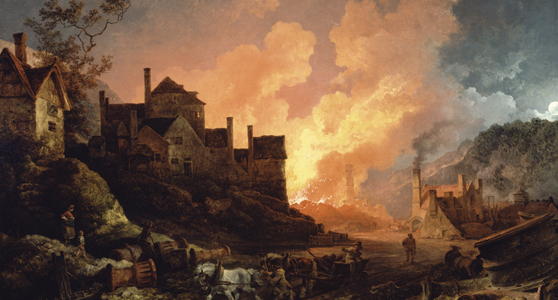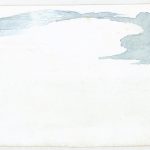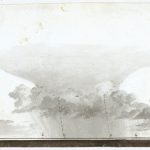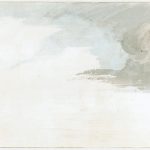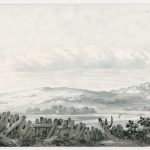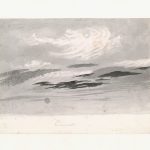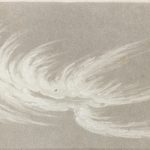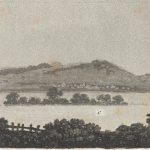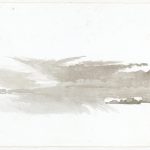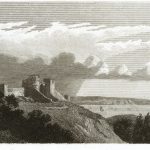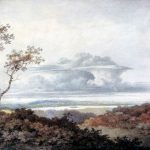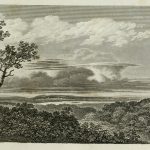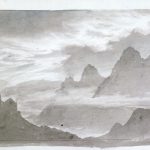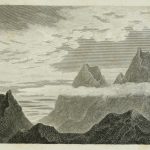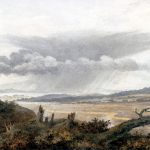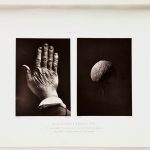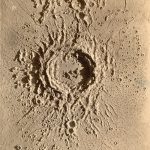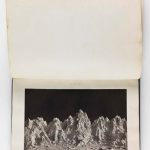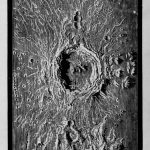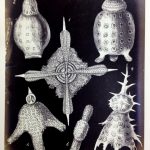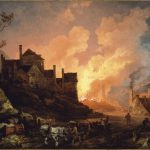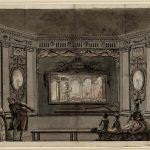Made real: artifice and accuracy in nineteenth-century scientific illustration
Abstract
https://dx.doi.org/10.15180/140208/001In their 1992 essay ‘The image of objectivity’, and again in Objectivity (2007), Lorraine Daston and Peter Galison describe the development of ‘mechanical objectivity’. Nineteenth-century scientists, they argue, pursued ‘truth-to-nature’ by enlisting ‘self-registering instruments, cameras, wax molds, and a host of other devices […] with the aim of freeing images from human interference’. This emphasis on self-recording devices and the morals of machinery, important as it is, tends to focus our attention away from the often messy and convoluted means of image reproduction – by lithograph, hand-coloured engraving or photomechanical process, and often involving steps that seem sharply at odds with narratives of increasing standardization and scientific restraint. This essay draws on the Science Museum’s pictorial collections in order to look again at the construction of objectivity, this time from the point of view of making and reproducing images. Case studies are presented of the Luke Howard collection of cloud drawings and James Nasmyth’s lunar photographs, suggesting that scientists were more flexible in their approach to depictions of the truth than has previously been supposed, and that ‘manufactured’ may be a better term than ‘mechanical’ when we talk of objectivity in the nineteenth century. But this is also a reflexive story, about the collections of the Science Museum – an institution whose own history is, I argue in conclusion, particularly tied up with issues of accuracy, depiction and genre. These are brought together in the consideration of ‘atmosphere’ – a term as important for the historian of science as for the exhibition curator.
Keywords
image production, James Nasmyth, Luke Howard, objectivity, photography, Romanticism, scientific illustration
Introduction
https://dx.doi.org/10.15180/140208/002An oddity of the ongoing ‘visual turn’ in science studies is the discrepancy between the careful attention now paid to scientific images, and the sporadic attention paid to how those images were in fact produced. What is well known to art historians – that the materiality of the image and complexity of image making are constitutive of genre and aesthetic effect – has remained obscure to historians of science who are otherwise increasingly engaged with visual language and strategy (e.g. Baxandall, 1995). The mystery deepens if we consider the extent to which the discipline has elsewhere been concerned with ‘opening up the black boxes’ of mediating technologies, and with the practices of theory-making (Latour, 1987; Clarke and Fukimura, 1992; Roberts, Schaffer and Dear, 2007). More often than not, scientific and technical imagery is discussed as if its appearance on the page or the screen was a naturally occurring phenomenon rather than the work of the copper-plate engraver, the landscape painter or the computer programmer.
There are, of course, exceptions.[1] One particularly influential attempt to grapple with the process of image-making is to be found in Lorraine Daston’s and Peter Galison’s treatment of ‘mechanical objectivity’, described first in a 1992 essay and again in Objectivity (Daston and Galison, 1992, 2007). In these works Daston and Galison describe how scientists working in the nineteenth century pursued ‘truth-to-nature’ by enlisting ‘self-registering instruments, cameras, wax molds, and a host of other devices […] with the aim of freeing images from human interference’ (Daston and Galison, 2007, p 121). Here we have a neat interweaving of the practices of theorising and image-making – precisely because the scientific practice in question was image making. No doubt, this is an important development in scientific representation: self-recording devices were certainly novel and elicited much comment. Yet the nineteenth-century also saw a flood of innovations within the much older technology of book printing, for example the development of chromolithography, steel engraving, and photo-mechanical illustration. Moreover, these techniques were often used in addition to the instruments of automatic engagement with nature, precisely in order to bring scientific illustration to a wider audience and cater to that audience’s expectations. It is with the technologies and conventions of image production that the present essay is concerned.
My essay begins with a close analysis of meteorologist Luke Howard’s cloud sketches, which date from the beginning of the nineteenth century and accompany his novel classificatory scheme – the cirrus, stratus and cumulus of modern weather-watching. In looking at Howard’s clouds it is my purpose to show that, as this coolly scientific classification of untamed nature took hold, the imagery with which it was associated was increasingly bound by the conventions of Romanticism, and in particular the rugged ruralism of the picturesque. Lest this imaginative trend be thought limited to the first half of the nineteenth century, the remainder of my essay considers the impact of photography on the interpretation and depiction of scientific subjects. In particular, I look at the lunar photography of James Nasmyth, which exhibits neither straightforward ‘truth-to-nature’ nor strictly ‘mechanical’ objectivity. Indeed Nasmyth’s photographs are typical of what I call ‘manufactured objectivity’, in which qualities later to be deemed subjective or contrived are praised for those very same reasons. Moreover, the persistence of convention and the praise of contrivance were not hindrances to objectivity – rather they were its guarantors, a fact that can only be revealed by looking at issues of genre and technique. My case-studies are drawn from the pictorial collections of the Science Museum – an institution whose own history is, I argue in conclusion, particularly tied up with issues of accuracy, depiction and generic convention. These are brought together in the consideration of ‘atmosphere’ – a term as important for the historian of meteorology as for the exhibition curator.
Luke Howard’s clouds and the persistence of convention
https://dx.doi.org/10.15180/140208/003The meteorologist and chemist Luke Howard (1772–1864) appears, in many ways, a pioneer of mechanical objectivity. He is most famous for his classification of cloud-forms, introduced in an 1802 lecture to the Askesian Society – a practically oriented and largely non-conformist group dedicated to natural and experimental philosophy. Here we have the first successful classification of clouds – previously thought too changeable to be brought into a scientific system. In line with the move from ‘truth-to-nature’ to mechanical objectivity Howard later turned to longitudinal studies of the weather, making extensive use of a self-recording barometer, whose ‘autographic curves’; he reproduced in Barometrographia (1847). What’s more, Howard’s clouds have long been taken as exemplary of the intrusion into early-nineteenth century landscape painting of scientific standards of observation – so that just as the real, ‘warts-and-all’ specimen came to replace the ideal type in scientific depictions of the natural world, so too in fine art the idealised tree turned into an identifiable oak and the cloud into a cirrostratus (Klonk, 1996). Hence the questions that have typically been addressed to Howard’s work, in the main by art historians, have tended to relate to Constable’s cloud studies and their indebtedness (or not) to the classification (Badt, 1950).
As for Howard’s cloud classification itself, analysis has been relentlessly linguistic. One of the major virtues of (and at times obstacles to) the classification was that it was written in what Howard called the ‘universal language’ of Latin – superseding Lamarck’s colloquial French version and giving rigorous definitions of each term, again in Latin. As we will see, the early uptake of Howard’s system was muddled by its inconsistent translation into English. In light of the plentiful material on Howard’s language, it is not surprising that the only book-length treatment of Howard’s classification – Richard Hamblyn’s The Invention of Clouds (2001) – is in the main concerned with the complex rhetorical strategies and personal allegiances that were mobilised in order to fend off competing nomenclatures (Hamblyn, 2001).
But what of the remarkable collection of cloud sketches by Howard, now held at the Science Museum and arguably the richest single source for understanding Howard’s work? As Ron Broglio has shown, Howard used painterly terms in order to convey the exact meaning of his new terms (Broglio, 2008, pp 146 ff). It is the argument of this section that, paralleling this painterly vocabulary, Howard also deployed the conventions of picturesque painting in order to secure the acceptance of his scheme through the images that went along with his texts. Here we find, especially in Howard’s collaboration with the painter Edward Kennion, an ever increasing interdependence of scientific objectivity and generic convention, most notably in the definitive publication of Howard’s Essay in 1865.
Although there is a large literature on the picturesque, and the genre is by no means conclusively defined, it is the term best suited to the effect that we see in Howard’s illustrations. I use it, therefore, in the broad sense of denoting a studied naturalism, in which staple objects (trees, clouds, castles), themselves based closely on natural observation, are placed in a variegated scene (i.e. lacking symmetry and with great depth). This has the benefit of matching closely the definition used by one of my principal actors, Edward Kennion (Kennion, 1815).
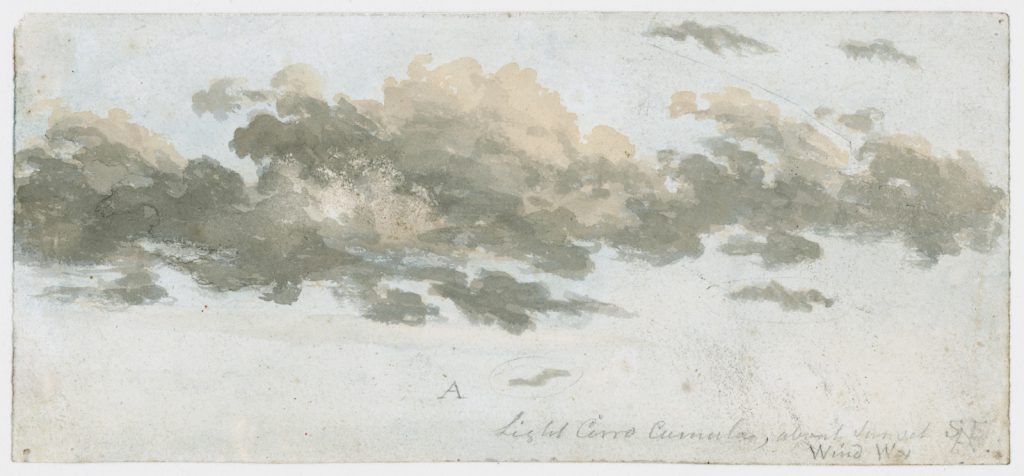
The location of many of the sketches gives us an initial hint of their Romanticism. For many years Howard travelled between London and the Lake District in order to capture the full range of what he termed ‘cloud modifications’, training himself in the notoriously difficult art of depicting clouds, of fixing them as they changed – sometimes slowly, sometimes rapidly – from stratus to cirrostratus, from cumulus to nimbus. These cloud sketches provide a remarkably intense record of Howard’s struggle with the ever-changing atmosphere. Some are barely begun, with just the outline of a scene that perhaps shifted too fast – some very complete, seemingly prepared for presentation or publication, with diagrammatic lines and lettering added.
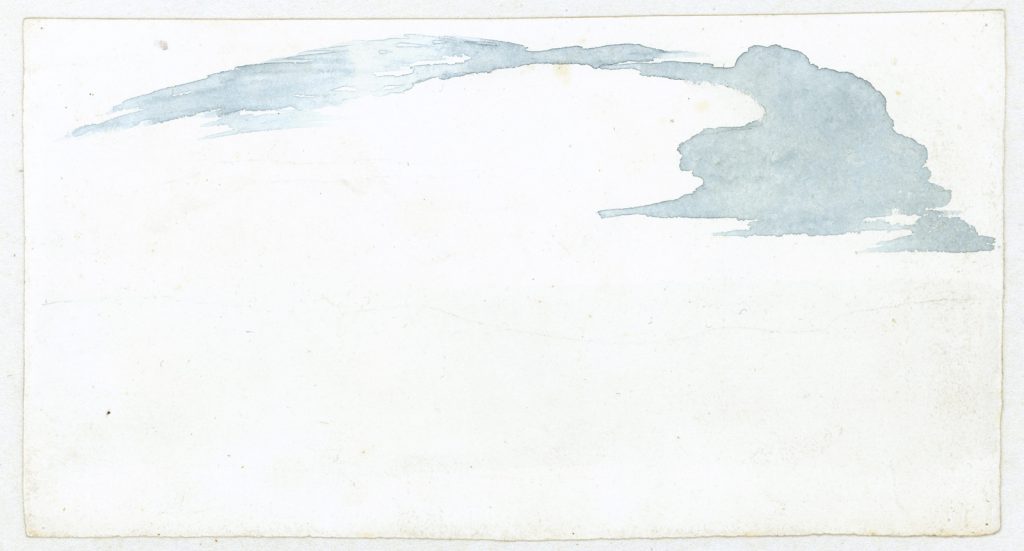
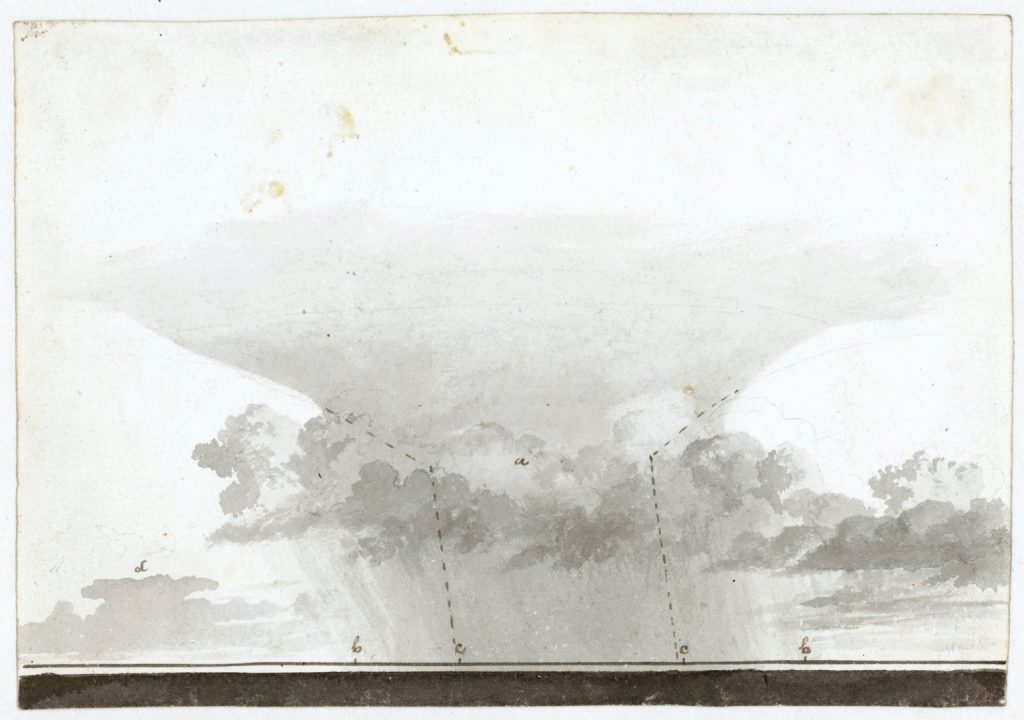
Establishing how these sketches were composed and the purpose for which they were intended is extremely difficult – the phrase ‘further research is needed’ could have been coined for these enigmatic illustrations. My purpose here is merely to begin the analysis, all the while bearing in mind the question of objectivity and how it relates to the making of images. The first thing to note, then, about these sketches is not the clouds themselves, but the preponderance of white space. In many cases Howard sketched in only the upper part of the paper, leaving the rest blank.
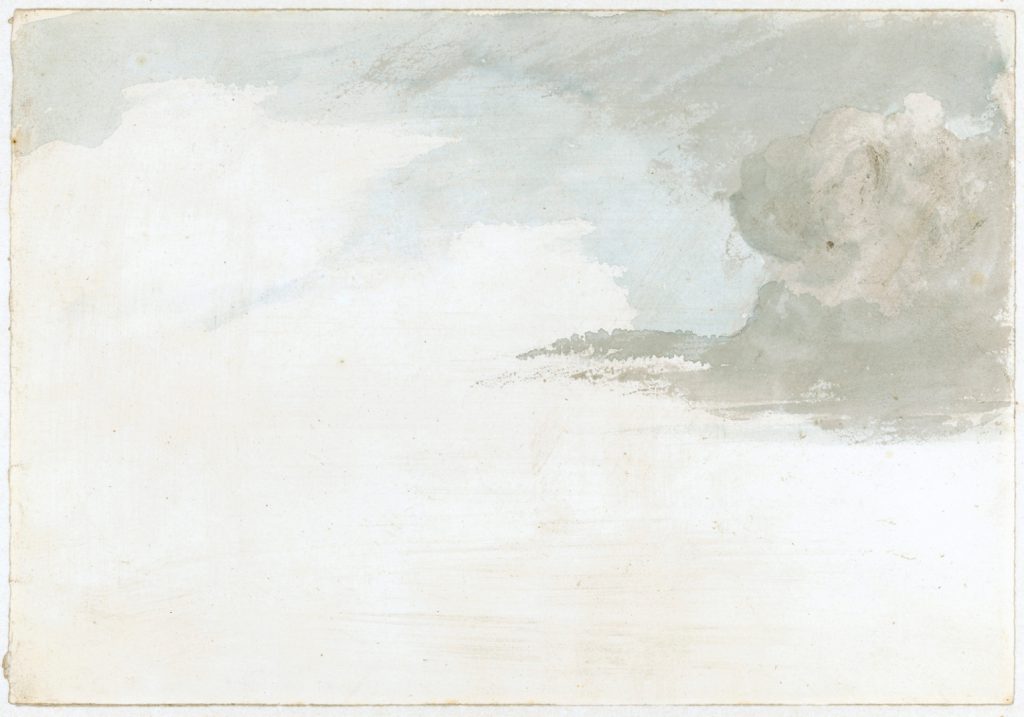
Here we have Howard’s first concession to painterly convention, albeit a small one. As we can see from some of the more finished sketches, the landscape itself was to be added after the clouds were finished. Howard, though expert in the depiction of clouds, was not a trained artist, and he needed assistance to complete the scene.
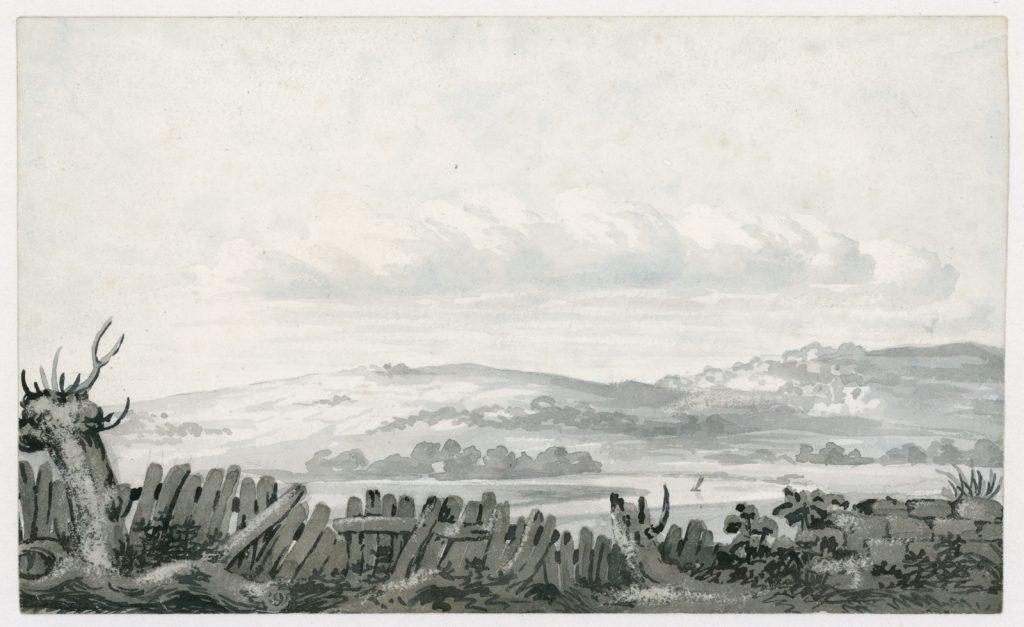
As I discuss in more detail below, Howard is known to have worked with the painter Edward Kennion, and it is likely that it was Kennion who embellished these early sketches, in one case even beginning a landscape without clouds and thus reversing the order of composition. But though the sketches are intriguing, there is vanishingly little evidence of the eventual or supposed use of most of them – even those labelled as diagrams seem not to have found an eventual published home – and so it is to the convoluted publication history of Howard’s clouds that we must turn if we are to establish the true role of imagery in the success of his classification.
The text of Howard’s lecture to the Askesian Society was published almost immediately in Alexander Tilloch’s Philosophical Magazine, appearing in three parts in the second half of 1803 (Howard, 1803a, 1803b, 1803c). The second of these was illustrated with three engraved plates, in which the seven modifications were shown (Hamblyn, 2001, pp 269–72). Here, perhaps surprisingly given the stylistic complexity of the sketches, details other than the clouds themselves are at a minimum. One of the limitations of copperplate engraving is that chiaroscuro is achieved by cross-hatching, so the great subtlety of the original watercolour becomes the somewhat crude delineation of the print.
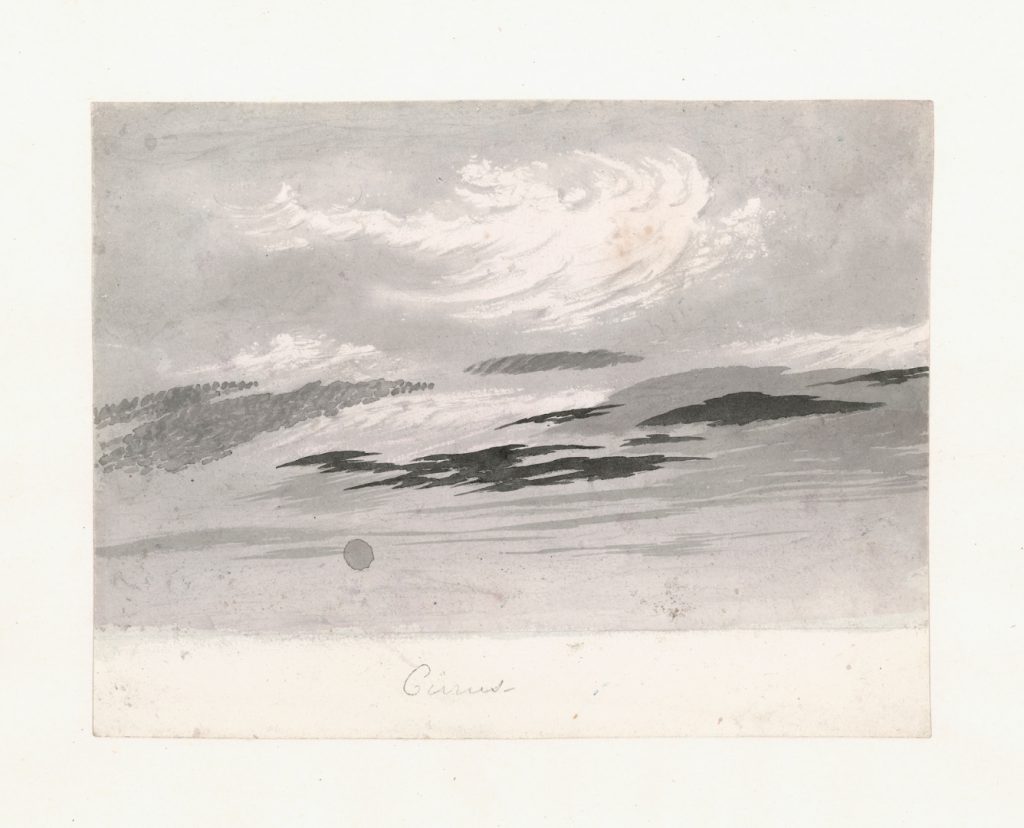
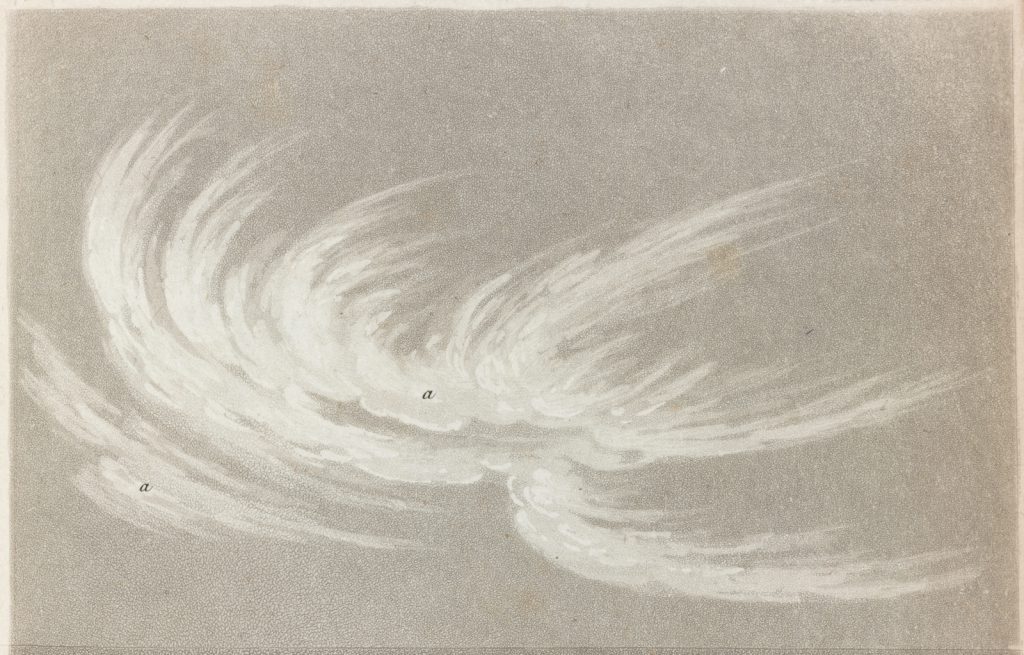
Of course, the virtue of this necessity is that the endlessly variable clouds themselves and the richly textured watercolours become fixed into the seven concrete forms – edges that were indefinable in the sky or on the easel become clear and sharp on the printing plate, suiting the nascent conventions of the encyclopaedic diagram (Klingender, 1947).
Where landscape is used in these illustrations, it is mainly pragmatic. The depiction of stratus clouds is particularly difficult in copperplate, because by convention the blue sky itself is already indicated by close horizontal lines. Here the ruling machine invented by the engraver of the plates Wilson Lowry, which allowed exceptionally fine delineation, proved essential. Howard further differentiates foreground and background by showing clouds among the landscape, with the tip of a hill poking up out of the vapour.

But by far the most dramatic of this first set of illustrations is one that shows the transformation of the three main cloud-types into the rain cloud, nimbus. This singular image required no diagrammatic lettering and is not subdivided like the others – already it has a painterly, illustrative appearance. In the foreground that picturesque staple, the castle, gives depth to a view that includes a lake and a distant hill.
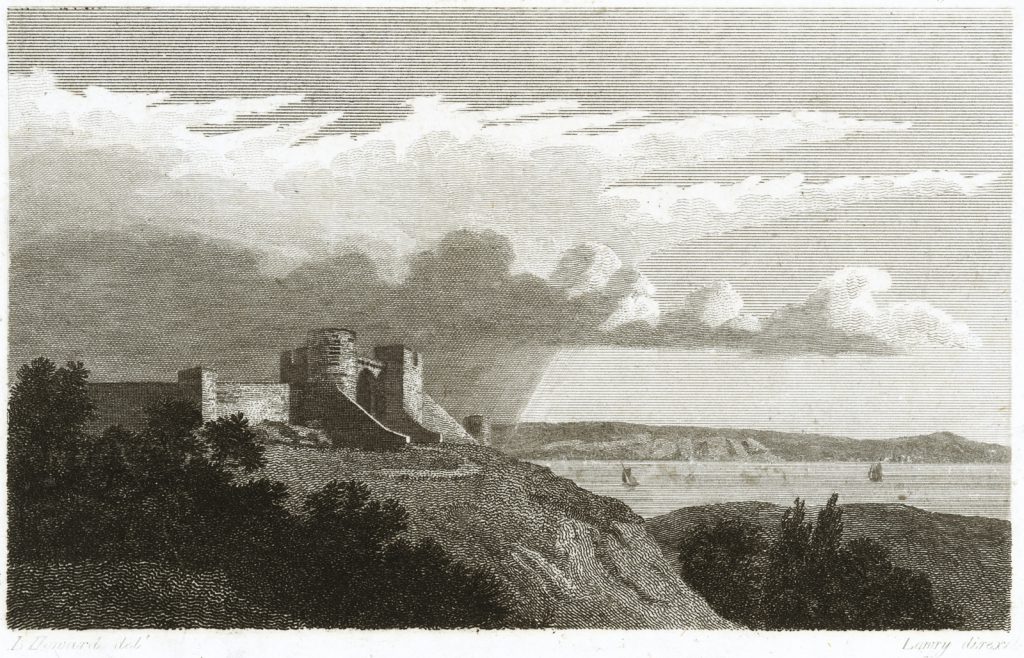

Here it is important to note the functionality of the landscape. The dark clump of trees and sunlit face of the castle give the full range of shade necessary to interpret the clouds. The complexity of the landscape further enhances the differentiation evidence in the sky – as Howard put it in the accompanying text, the ‘principal modifications [of clouds] are commonly as distinguishable from each other as the tree from a hill, or the latter from a lake’, all of which are included here (Howard, 1803a, p 98; see Jacobus, 2012). Finally, the boats on the lake, far from being a kind of painterly tick, give us a clear indication of the direction of the wind, which carries the cumulus clouds into the massed nimbus. But as hinted at by the castle there is generic convention at work here in addition to the more purely diagrammatic elements.
As Hamblyn has shown, Howard’s scheme was quick to catch on, proving far more successful than any previous attempt to classify the clouds, and even attracting the attention of the great German poet and naturalist Goethe (Slater, 1972). Beyond this celebrity endorsement, success for Howard meant primarily that the cloud names were used in the meteorological tables in publications like the Philosophical Magazine, William Nicholson’s Journal of Natural Philosophy, Chemistry and the Arts, and the Gentleman’s Magazine.
It was in the last of these that the sketches made their next appearance, appended to a letter from the most fervent early adopter of the new classification, the young astronomer and meteorologist Thomas Forster. Here we see the simplest presentation of the scheme, engraved after sketches that Forster calls ‘rough, but accurate’ (Forster, 1811). Almost contemporary with this, an updated version of Howard’s essay had appeared in Nicholson’s Journal without any illustration at all. At this point – with Howard’s classification clearly mapping on to Daston’s and Galison’s category of ‘truth-to-nature’, in which ‘reasoned images’ are presented, often stripped of all adornment and colour – we might expect the imagery of clouds to stabilise. The classification was a success, and Forster had supplied a handy identification guide to the extensive readership of the Gentleman’s Magazine.
Quite the opposite happened. Not only did Forster begin to extend the linguistic range of Howard’s scheme, but a bewildering range of new illustrations appeared, taking the clouds ever further into the realm of the picturesque and ever further from simple restraint, let alone mechanical objectivity. The first step was for Forster to produce his own illustrations in a book entitled Researches about Atmospheric Phaenomena (Forster, 1815). The scenes depicted here are clearly inspired by Howard’s collaboration with Kennion, and may in fact consist of Howard’s sketches surrounded with Forster’s landscapes – though the overall effect is quite rough by comparison with Kennion’s paintings. On the other hand, the clouds are reproduced lithographically for the first time, and the sky has been tinted in a rich blue. Here a rural scene is always used – and nor was this anathema to Howard’s cosmopolitan Latin, for even if he did not go as far as Forster, who appended English translations and colloquial names to the original classification, Howard insisted that his work united the ‘two kinds of knowledge’, with natural philosopher on one side and ‘the shepherd, the ploughman, [and] the mariner’ on the other (quoted in Anon, 1819).
Another dramatic alteration of Howard’s original scheme that is first evidenced in Forster’s illustrations is the breakdown of temporal order. Where the rain cloud scene engraved in the Philosophical Magazine expressly showed a moment in the development of the nimbus, Forster’s images now combine cloud modifications that could not possibly coexist, even juxtaposing different weather systems in the same image.
Surprisingly, when Howard had a greater hand in preparing the images the virtues of simplicity and restraint were even more conspicuously absent. In Rees’s finely produced Cyclopaedia, for example, four plates were provided to illustrate the lengthy exposition of Howard’s work. These engravings were based on works by Edward Kennion, and all of them are dramatic landscapes. In these illustrations, the detail, in particular of depicted observers, enhanced the sense of a real scene, even as the sky contained an unreal, systematic range of clouds. Here we can see a tension between Howard’s systematic intentions and Kennion’s usual style. Kennion was not only an expert on the picturesque, but was a pioneer of the accurate depiction of natural phenomena. The dominant presence of foliage – delineated in great detail – is a reflection of Kennion’s obsession with the accurate depiction of trees, the necessary adornment, in his view, of any successful landscape (Kennion, 1815).[2] So now we have Howard’s clouds – drawn directly from observation but combined in unnatural ways, alongside Kennion’s highly naturalistic but formally idealised landscape.
It is in this the Cyclopaedia sequence of works that we can see most clearly the Romantic categories of depiction at play. While Kennion typically sought the ‘picturesque’ or even the calmly ‘beautiful’ in his work, Howard tended to the more extreme ‘sublime’, in which strong emotional responses are inspired, only to be subdued by the reassertion of rational control over the scene. Plate II, for example, features two figures, one in which a sketch by Howard with embellishment by Kennion has been further added to at the point of engraving, eventually printed showing cirrus passing to cirrocumulus above cirrostratus, cumulus, and cumulostratus, all far behind a leafy scene.
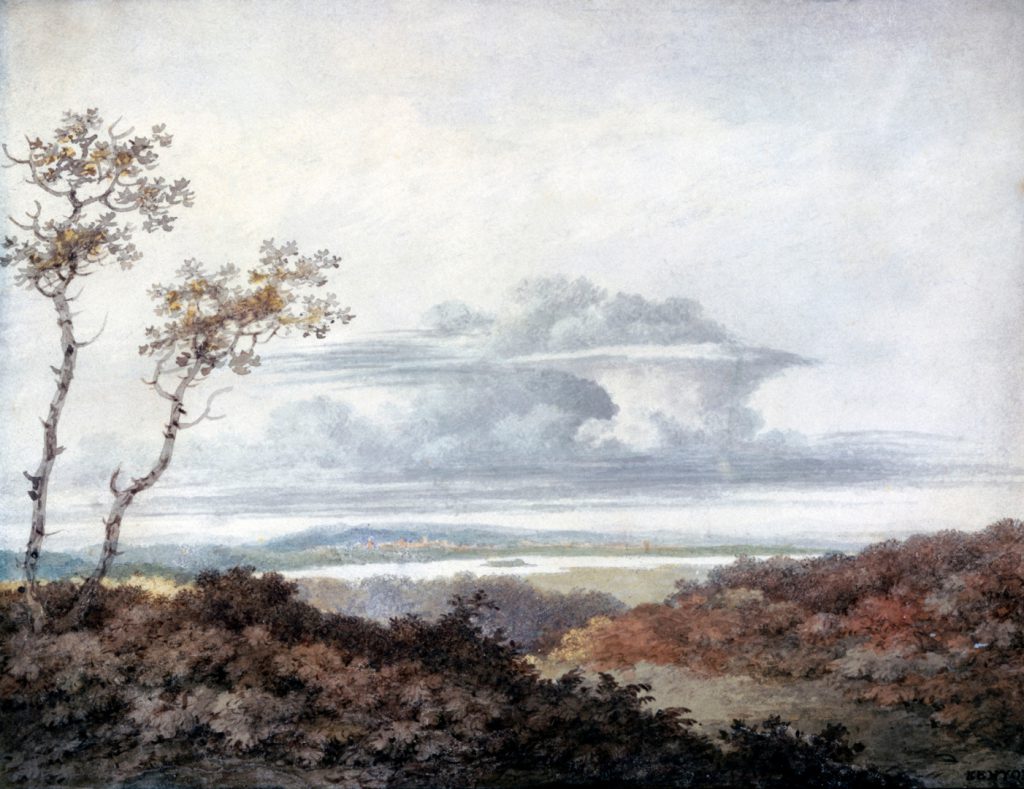
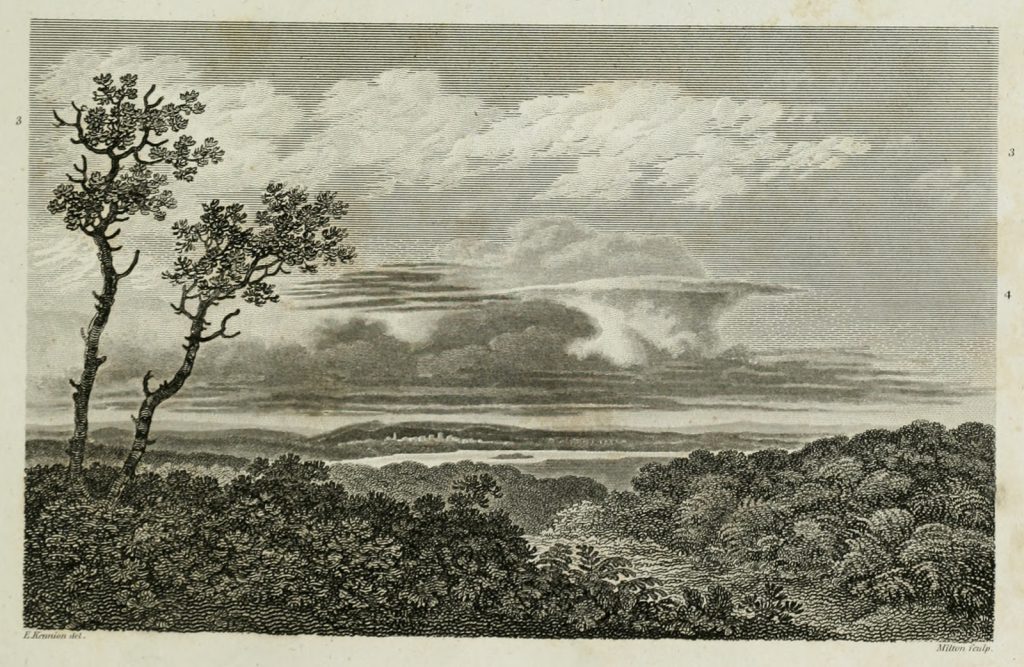
The second of the two figures is even more informative. Here we have what is almost certainly a full landscape by Howard, one of the few that can be so identified, because the cloud fully shrouds the mountains, which in any case are crudely depicted. This, in the Cyclopaedia and presumably without further work by Kennion, has been engraved by Thomas Milton, who had previously (and appropriately enough) produced engraved versions of Romantic paintings such as The Deluge by Philip James de Loutherbourg. Here we are closer to the sublime landscapes of the period than to a typical encyclopaedic diagram, and another plate in the Cyclopaedia features pitifully small figures gesturing to the skies, reinforcing the comparison with other more famous Romantic works of the period, such as those by the German artist Caspar David Friedrich.
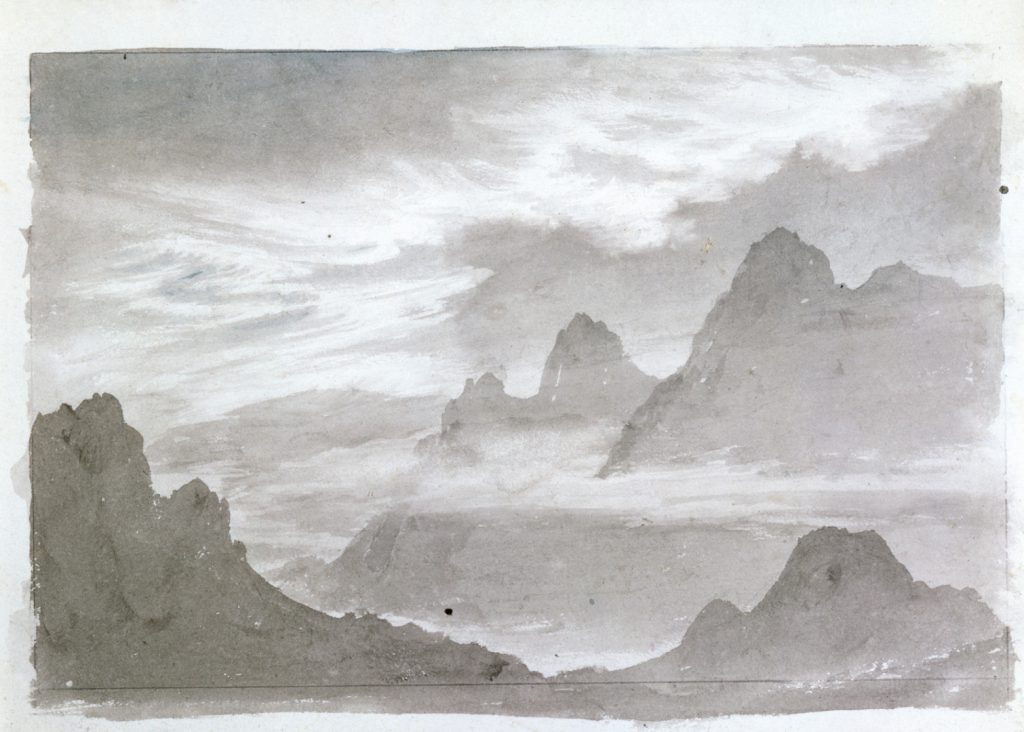
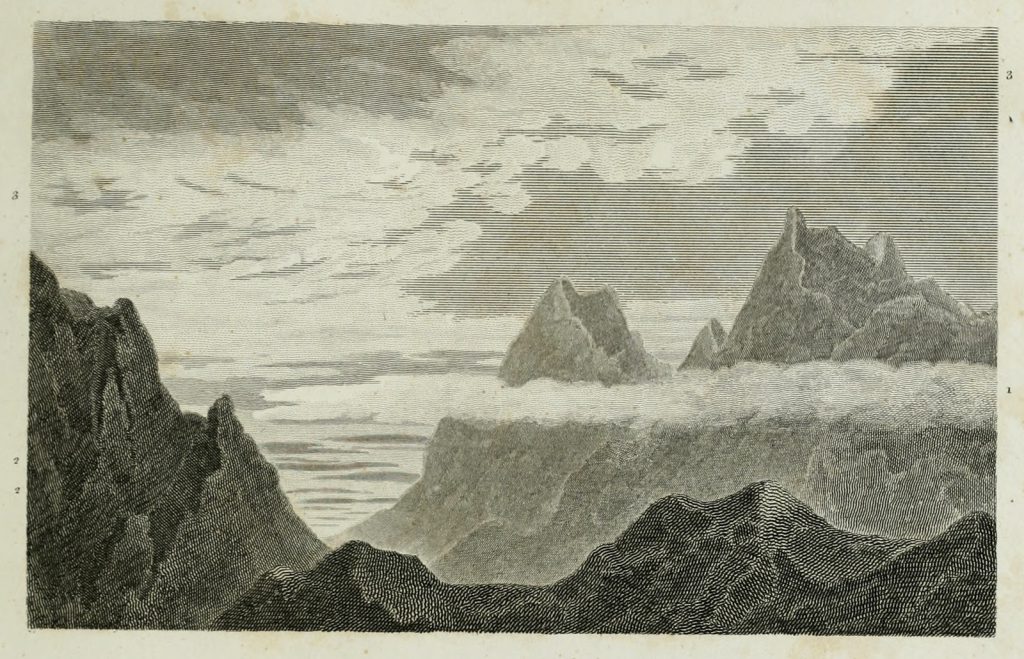
The clouds of Howard’s sketch have again become more sharply delineated, some ‘distant cirri-strati’ have even appeared between the two mountain ranges – but in Milton’s engraving the mountains have become far more craggy and impressive than in the sketch, details for which de Loutherbourg’s melodramatic painting would have provided ample preparation.
As the classification became established new books or encyclopaedia articles featuring the cloud images appeared with increasing rapidity, typically embellishing Howard’s basic sketches in some new way. One of the Philosophical Magazine group, for example (see Figure 10), was to re-appear in George Harvey’s 1834 Treatise on Meteorology, with a whole new foreground of foliage added, the boats now reduced to mere details, almost along with the clouds themselves – yet the whole was produced ‘under the inspection of Luke Howard’. Even when diagrammatic conventions eventually took over towards the end of the century, this image continued to be reproduced as part of the set.
But the final triumph of the picturesque was to come as late as 1865, when Howard’s Essay was reprinted in its definitive form (Howard, 1865). This publication was arranged by Howard’s grandsons, their father having died the previous year. At last the set of finished Kennion/Howard collaborations was collected together, now reproduced in subtle lithography alongside Goethe’s poem in honour of Howard’s work. In this edition, the images are all reproduced lithographically, allowing the complexity of the clouds to return from their sharply outlined engraved form. This, in combination with the rough nature, the landscape embellishments and the just-classifiable variability of the clouds themselves make this the supreme picturesque version of Howard’s Essay (Gilpin, 1789).
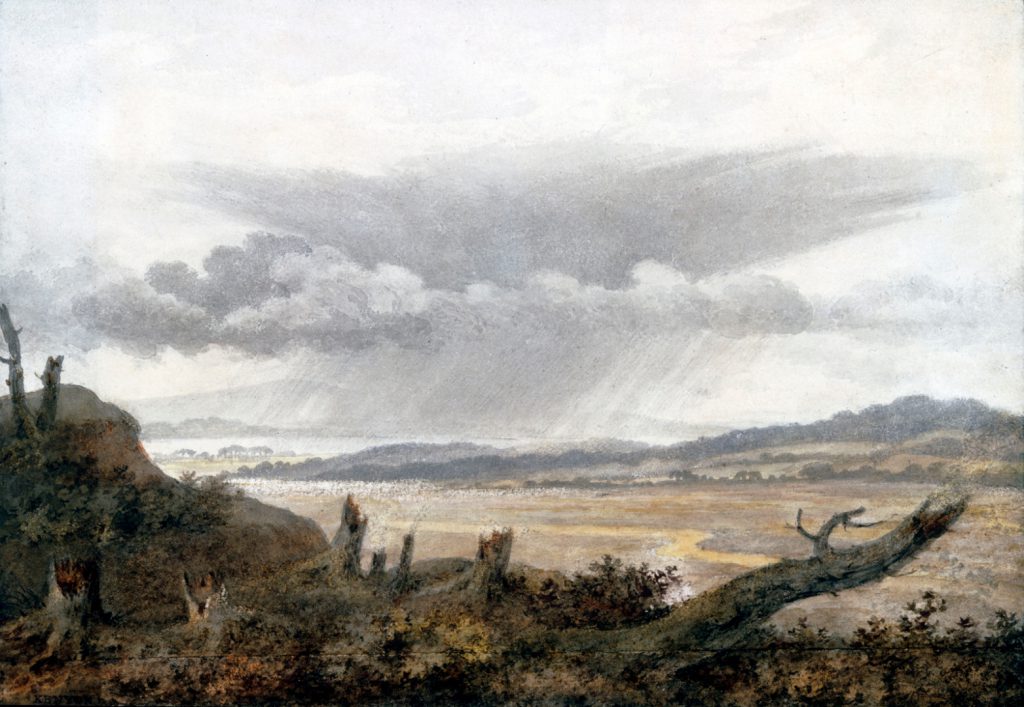
By this time, of course, cloud photography was a realistic alternative (earlier exposure times having been far too long). And in this third edition of Howard’s Essay the editors recommended two sources of images alternative to Kennion’s: the spectacular steel engravings by James Charles Armytage in John Ruskin’s Modern Painters; and the prize-winning stereoscopic photographs prepared by James Washington Wilson of Aberdeen. Here, instead of the expected beginnings of the art/science split described by Daston and Galison, we see Armytage’s and Wilson’s clouds recommended alongside each other as a necessary complement to Howard’s studies.
Yet photography did eventually play a decisive role in cloud classification – as Lorraine Daston has shown, it was the photographic cloud atlas of 1896 that was to begin the standardisation of cloud observations that had become hopelessly fragmented in the intermediate years (Daston, 2008, pp 102 ff). Again we sense the triumph of mechanical objectivity. But photography itself was far from being the straightforward tool of disinterested truth-to-nature that some of its early advocates describe. Where my case-study of Howard and his cloud sketches shows that the conventions of the picturesque persisted for longer than we might expect, my next examples show that even after the advent of photography there could be many, many stages between an observation and its eventual portrayal on the page – and, what’s more, the convoluted production of an image was anything but an obstacle to its acceptance.
Making scientific photography
https://dx.doi.org/10.15180/140208/004As Daston and Galison readily acknowledge, ‘the photographic image did not fall whole into the status of objective sight; on the contrary, the photograph was also criticized, transformed, cut, pasted, touched up, and enhanced’. ‘Not all objective images were photographs,’ they continue, ‘nor were all photographs considered ipso facto objective’ (Daston and Galison, 2007, p 125). And yet even with this caveat, there are cases that fit uncomfortably, if they fit at all, within the framework of mechanical objectivity. It would seem, for example, that often the virtues of disinterest and restraint were inverted, and outlandish or long-winded interventions in the image-making process were celebrated as conferring rather than diminishing objectivity. At times it seems as though, far from generating controversy or calling into question the objectivity of the photograph, the more stages involved in making an image the better.
Take, for example, the lunar photographs of James Nasmyth, the Scottish engineer who had achieved fame and fortune with his invention of the steam-hammer, and who had retired to the aptly named ‘Hammerfield’ in order to pursue his astronomical obsessions. Nasmyth’s magnum opus is The Moon: Considered as a Planet, a World, and a Satellite (Nasmyth and Carpenter, 1874). This work, first published in 1874, was among the first to include photo-mechanically reproduced prints, and for this reason, as well as for its startling visual analogies, it has come to be seen as a landmark in the history of the scientific use of photography.
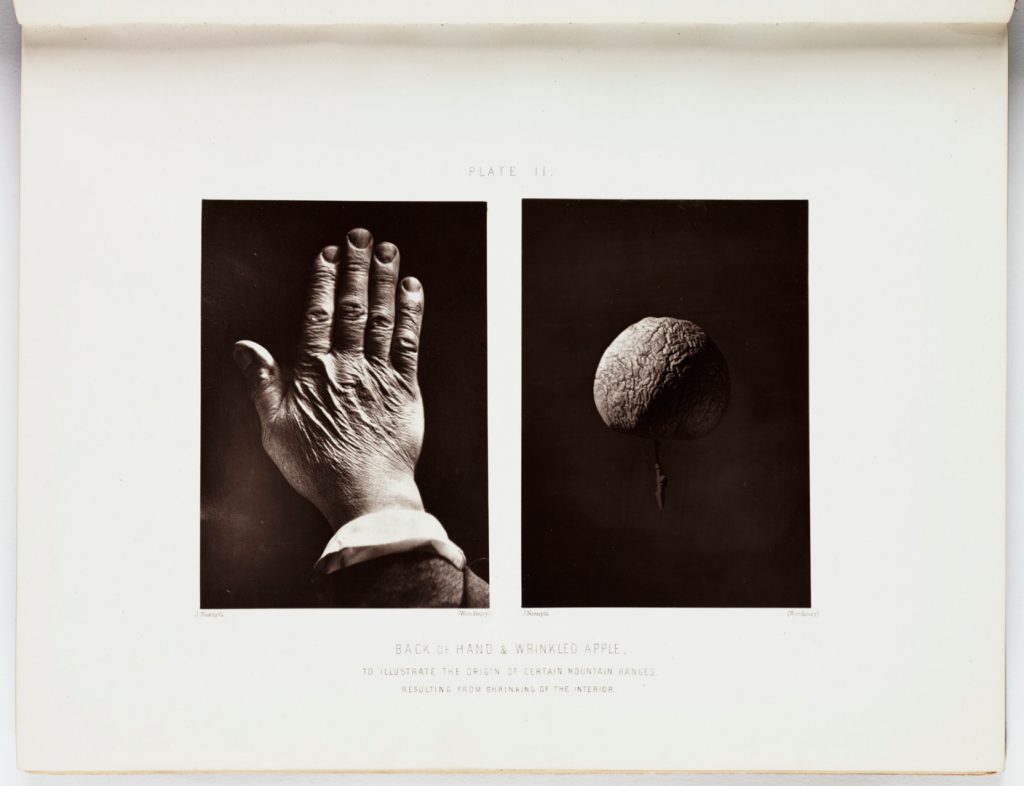
At the time of its publication, too, reviewers were held spellbound. No less an authority than the astronomer Norman Lockyer, founding editor of the journal Nature, lavished praise on the book, singling out its illustrations for particular praise:
No more truthful or striking representations of natural objects than those here presented have ever been laid before his readers by any student of Science; and I may add that, rarely if ever, have equal pains been taken to insure such truthfulness.
Just what were these ‘pains’ that had occupied Nasmyth? True, he had been occupied with observations of the Moon for more than thirty years, having eventually constructed his own telescope, even casting the large speculum mirror himself. His skill in drafting was already established by the time he took up lunar observation – as his sketchbooks attest he was particularly skilled in swift depiction, with some of his illustrations noting the precise time it took to finish them. Nor was training oneself to observe the Moon, which must be continuously tracked across the sky, an easy task: Nasmyth is known to have learnt the details of the visible surface from the standard textbook Der Mond.[3]Yet it was not these pragmatic aspects of Nasmyth’s work that so impressed Lockyer – rather it was precisely the painstakingly involved process of the image-making itself that impressed him. For although Nasmyth had used both the latest photographic equipment and the latest photo-mechanical printing techniques, his images were anything but indexical records of the Moon’s surface. Using the excellent holdings of Nasmyth material at the Science Museum we can reconstruct his working procedure as follows:
First, Nasmyth would prepare chalk, pastel and crayon drawings of the observed crater, here ‘Copernicus’, working and reworking these over prolonged periods until they matched exactly what he saw.
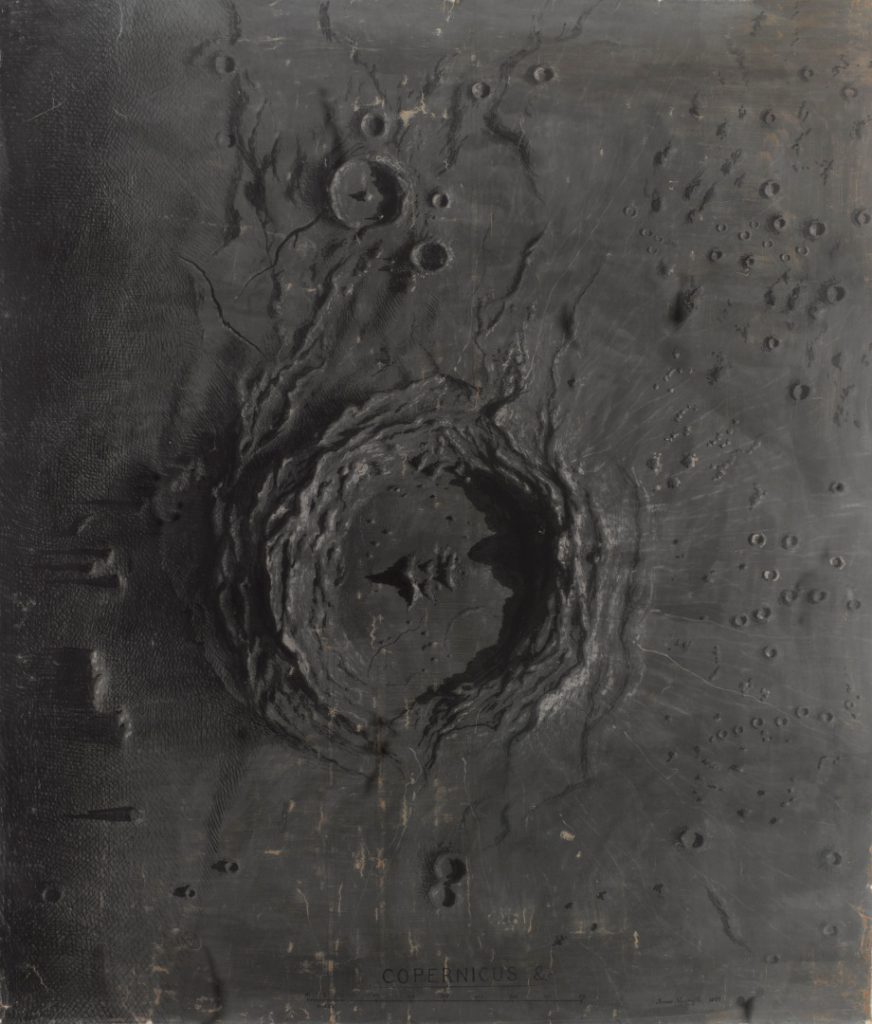
The next step was to take measurements of the shadows in order to estimate the heights of surface features. These were then modelled in plaster.
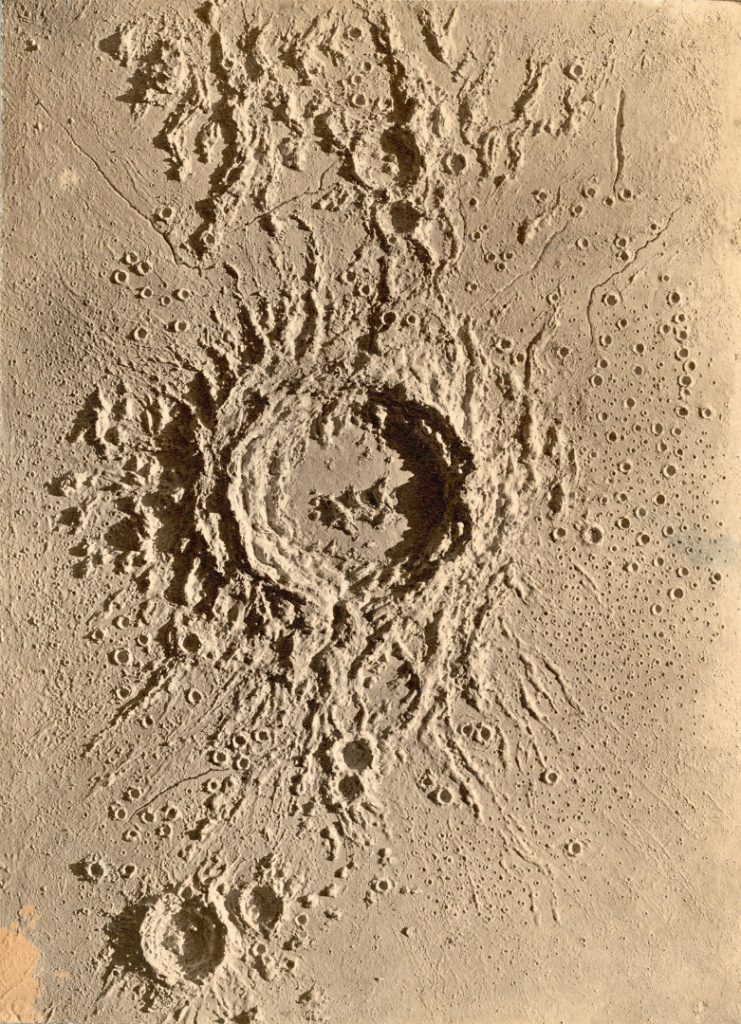
And finally the model of the original observational drawing was photographed in strong sunshine, the set-up so arranged that the angle of the Sun matched the drawing (though note that the drawing was of compound observations, so is not even an attempt to record a single moment).

Far from being deceived by the photographs, Lockyer knew exactly what had gone into their production, describing in outline the process and commenting that the images are ‘perfect’.
What Lockyer may not have been aware of, however, was Nasmyth’s diligence over the type of reproduction used for each image. The famous hand and apple photograph reproduced above, for example, uses the lower-contrast heliotype process, while the lunar photographs themselves are typically ‘Woodburytypes’, with a higher contrast matching the increased contrast found on the atmosphere-less Moon.
Nor was it only Lockyer who was impressed. Edinburgh Review carried an anonymous treatment that identified the talents of Nasmyth’s as those of ‘mechanical and engineering, rather than of mathematical or astronomical, science’, and emphasised that it was this combination that made his book ‘the most complete and intelligible description of the physical condition of the moon that has yet been published’ (Anon, 1875). Like Lockyer, this reviewer also favoured the ‘long, patient, painstaking labour, and the consummate skill of the artist’ exhibited by Nasmyth.
The success of Nasmyth’s images is all the more remarkable if we consider the various rivalries in astronomy in the period. Lockyer, for example, was engaged in a long-running battle with Richard Proctor over the role of imaginative reconstruction and popularisation in astronomy, and yet found nothing to criticise in the spectacularly imaginative reconstructions in Nasmyth’s The Moon.
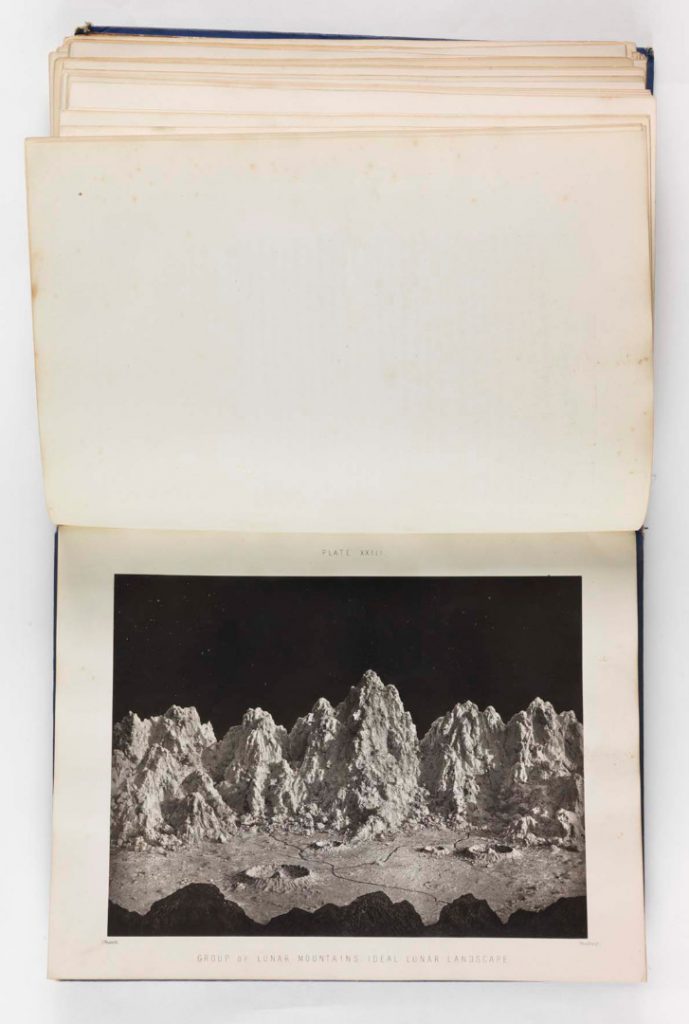
Here the lack of atmosphere in the subject is particularly well matched to what we might view as the limitations of the medium – a point well taken in another account of lunar imagery in Nature:
From the merely artistic point of view the artist fears his task may be a thankless one, for since the moon has no atmosphere, there is neither aërial perspective nor diffusion of light, but it is precisely this point which should make our artist all the more interested in this unique production. […] In a word, there is wanting in the lunar landscape that which lends to our earth perspective, richness of tone, modulation, softness, and temper. (Anon, 1878, p 469)
Proctor, meanwhile, may have sympathised over the possibility of imagining and depicting scenes on the lunar surface, but was in open competition with Nasmyth over the explanation of lunar craters: at the same time as Nasmyth was using The Moon to advocate volcanic origin, Proctor published a less spectacular but still finely illustrated book arguing that the craters were formed by meteoric impacts (Proctor, 1886). But in spite of this Proctor – just as his bitter enemy Lockyer had – singled out Nasmyth’s images for praise, even going so far as to reproduce (now in a wood engraving by Henry Adlard) one of the crater images in his own book on the Moon (Proctor, 1886, pp 249 ff).
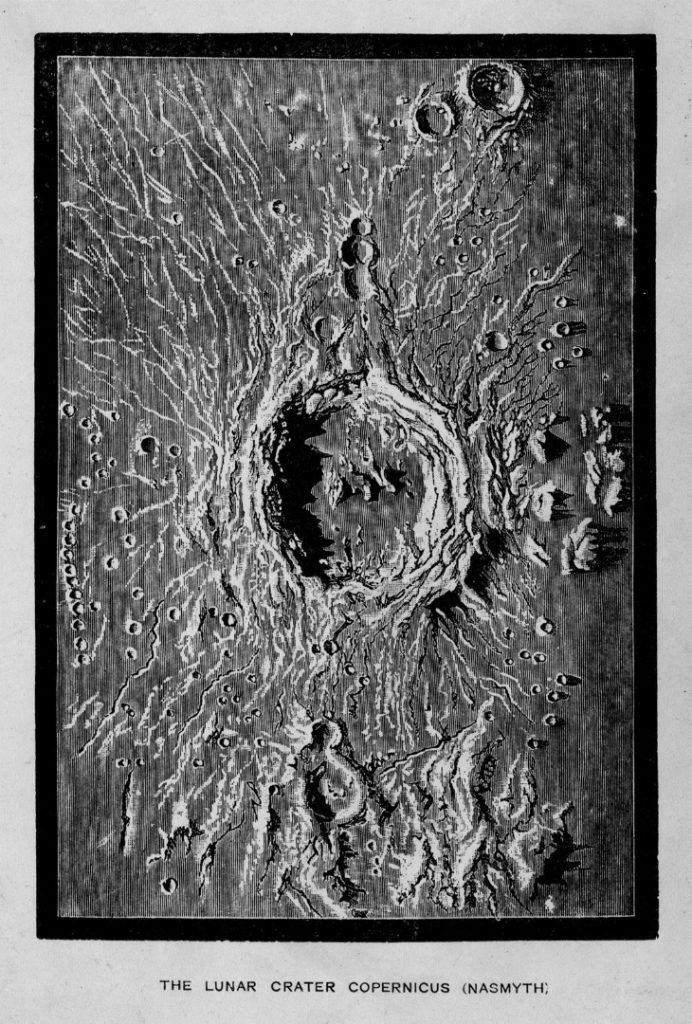
In her excellent essay on Nasmyth’s lunar imagery, Frances Robertson points out that Nasmyth’s background in engineering, and in particular his monumental invention the steam hammer, are not unrelated to his conception of the Moon as a plutonic environment, literally formed by the action of volcanos, metaphorically by the god Vulcan, called by Nasmyth ‘the head of our craft’ (Robertson, 2006, p 616). Hence the act of modelling might be more than a mere expedient to accuracy, instead becoming a means of controlling the unfathomable Moon – just as the picturesque is a means of controlling ever-changing nature (Liu, 1989, pp 64 ff). Here we can draw a more general point: thinking back to the case of Howard’s clouds it is clear that the demonstrable contrivance of image-making was far from a barrier to perceived objectivity – in Howard’s case, the progress of the classification was matched by the steady development of picturesque features in the cloud studies; in Nasmyth’s case the work that went into the production of the photographic record was itself considered virtuous, even allowing astronomers critical of the ‘imaginative’ mode to praise Nasmyth’s very obviously imaginative lunar landscapes.
Far from being a special case, Nasmyth’s multi-stage image-making process was, as Alex Soojung-Kim Pang (2007) has shown, central to the visual work of late-nineteenth century astronomy. Images of Mars, for example, were made on similar principles, with charts forming the basis for globes which were then photographed, and praised for their verisimilitude (Nall, 2013, p 56). Examples such as this can be multiplied, and though astronomy and meteorology may be particularly well-suited to the manufacture of such images, other disciplines will have their own peculiar and virtuously painstaking depictions. In zoology, for example, the tradition of manual illustration overlapped conspicuously with new micro-photographic techniques, most bizarrely with the sketches of ‘polycistins’ (single-celled organisms) by Priscilla Susan Bury, which were photographed and presented as straightforward microphotographs of the organisms themselves (e.g. Bury, 1862).

As with Nasmyth’s Moon, praise for Bury’s work was not diminished by recognition of the conspicuous contrivance of the resulting images. Geography too, was a science of high artifice: in 1865 Francis Galton advocated the technique of making stereographic maps from models of mountains (Galton, 1865), and these in turn were probably inspired by the frontispiece to Charles Piazzi Smyth’s report on his astronomical work on the island of Tenerife. This showed a stereograph of a model of the island’s peak made by Nasmyth himself (Piazzi Smyth, 1858). Thus we come full circle, from cartography – which gives the appearance of observed reality but is based on land-based survey work – to geographical photography based on models of that very same geography.
Where photography couldn’t contribute to scientific work – most obviously in the depiction of colour – the complexities were even greater. Again the Science Museum’s collections offer an intriguing glimpse of a nineteenth-century solution, namely the sunset sketches by William Ascroft, which were completed in a frenzy of activity following the eruption of Krakatoa in 1883. That event had led to the ‘remarkable sunsets’ that occasioned much discussion in the subsequent months – a major topic of which was the correct language required to describe the palette of each sunset. Ascroft, an artist who had long been concerned with the chromatics of the sky, set about using pastels to record the sunsets, often making many sketches in a single evening. When the Royal Society came to compile their report on the eruption and its consequences it was Ascroft’s illustrations that were chosen over the work of trained meteorologists. For this purpose Ascroft’s evocative images were reproduced using the latest lithographic technology provided by the Cambridge Scientific Instrument Company (Zaniello, 1981; Cattermole and Wolfe, 1987, p 38).
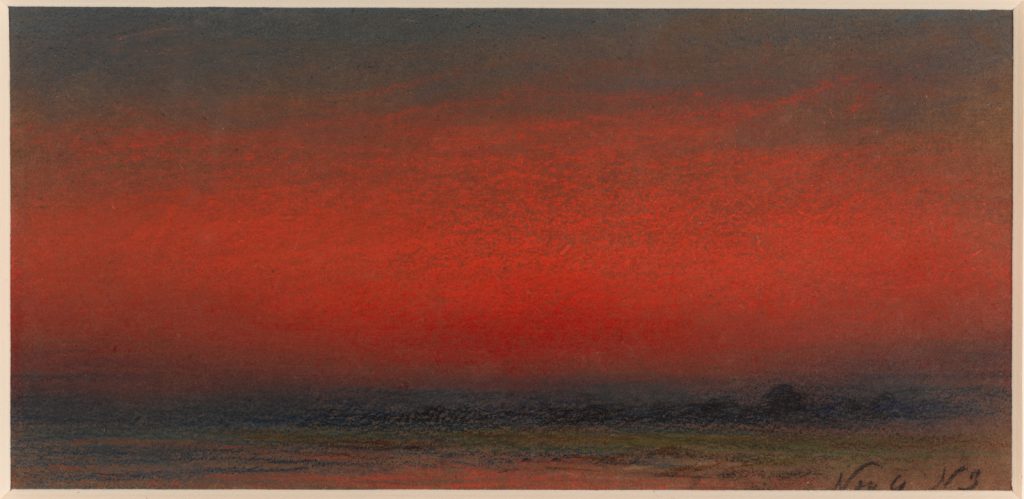
More generally, it should not surprise us that, when image-making involves the use of complex high technologies, the relationship between notions of objectivity and the unmediated depiction of nature becomes as highly complicated as in the cases of Howard’s clouds and Nasmyth’s Moon.[4]
Conclusion: art at the Science Museum
https://dx.doi.org/10.15180/140208/005My intention in this essay has been to offer a way in to discussion of generic convention and image production, as a contribution to the growing literature on representation in the sciences. But the choice of Howard and Nasmyth as examples is not merely based on their suitability for my argument – in the Science Museum their works share an institutional home that is highly apt for considerations of technical depiction.
The first serious attempts to add artworks to the Science Museum’s collection date from the 1950s. It was then that the vast collection of ‘aeronautica’ amassed by Winifred Penn-Gaskell began to arrive. Now the Museum had depictions of early balloon and heavier-than-air flight to accompany its excellent material holdings (Doherty, 2014). More controversially, in 1952 director Frank Sherwood Taylor acquired Philip James de Loutherbourg’s Coalbrookdale by Night, a magnificently dramatic depiction of iron smelting on the Shropshire borders (Anthony, 2010).
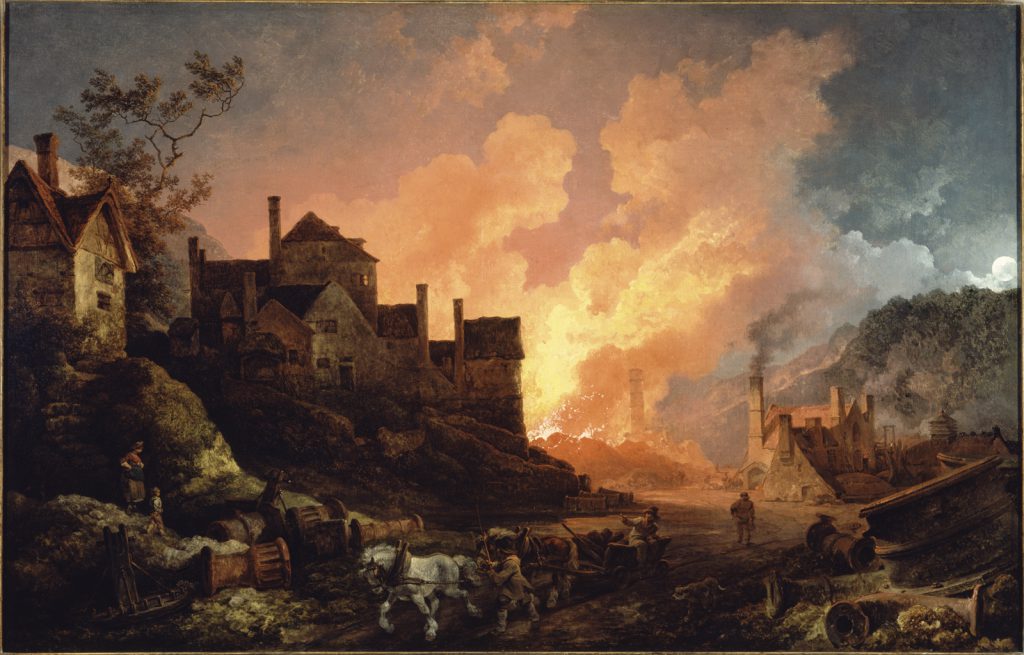
Almost immediately this purchase plunged Sherwood Taylor into highly involved discussion with his curators about matters of museology and art history. Sherwood Taylor had purchased Coalbrookdale in order, as he put it, to ‘fire the imagination of the spectator’, but to the Curator of Metallurgy Fred Lebeter, the painting was the inaccurate result of the overbearing Romantic imagination. Inevitably, the senior Sherwood Taylor (or perhaps the simple quality of the painting itself) won out, and to this day Coalbrookdale by Night plays an important part in the Museum’s depiction of the Industrial Revolution.[5]
The dominant quality of Coalbrookdale is of course the ‘atmosphere’ it brings to the depiction of a conspicuously man-made scene. This, after all, was the quality discerned by no less than Diderot in de Loutherbourg’s work (Baugh, 2008), and it was the quality sought by Sherwood Taylor as he attempted to ‘enliven’ the Science Museum’s ‘arid’ metallurgical displays.[6] As many writers on de Loutherbourg have shown, his atmospheric effects were derived from both his experience as a set-designer and his remarkable moving diorama, the ‘Eidophusikon’. This entertainment, subtitled ‘Various Imitations of Natural Phenomena’, consisted of a small stage on which de Loutherbourg used lights and artificial sounds to recreate such scenes as daybreak at Greenwich Park (replete with moving clouds), or the raising of Pandaemonium (replete with moving Satan).

Technology is doubly at the root of de Loutherbourg’s Romanticism, first in his use of industrial scenes in what he called Britain’s ‘Picturesque Scenery’, and second in the transference of mechanical entertainment to painting (de Loutherbourg, 1805).[7] And atmosphere defines de Loutherbourg’s work in both an art historical and museological sense: it is a shorthand for the transformation of landscape painting of which de Loutherbourg was a key witness. This was precisely the point Lebeter made to Sherwood Taylor when he criticised the painting – but what Lebeter saw as the distortions of painterly convention, Sherwood Taylor saw as a way in to the violent and awe-inspiring human story of industry (Anthony, 2010, p 94). The irony is that for de Loutherbourg’s contemporaries it was precisely the heightened emotion inspired by his work that allowed them to be called realistic (McCalman, p 78). Atmosphere is the very same quality – now mediating between art, technique and science – that we find astonishingly absent in Nasmyth’s Moon and hyper-present in Howard’s clouds. The sciences of the atmosphere, first among them meteorology and astronomy, were in no way divorced from the more general tendency to pursue painterly atmospherics, be it in the form of Romantic landscape in the manner of de Loutherbroug and Howard, or imaginative reconstruction and stark monochrome in the work of Nasmyth. More than this, my examples are outside the modern ‘two cultures’ thinking that too easily separates artistic and scientific work. That the picturesque was bound up with accuracy, and photography with artisanal skill shouldn’t surprise us, and yet frequently it has done. As is shown most clearly in the case of Howard’s clouds, picturesque conventions which required accurate subjects (clouds, trees, rocks) were themselves integral to the establishment of scientific authority.[8]
But these are relatively easy points for the academic historian to take on board and make use of – indeed one of the great virtues of Daston’s and Galison’s work has been the framework it has provided for people to work within and against.[9] For the museum curator, of course, things are slightly different, and the mechanics of image production do not necessarily make for an attractive exhibition topic. That said, the image as object is clearly preferable to the image as gallery-dressing. Examining the mechanisms, high-ways and by-ways and personal involvements of depiction suggests a more complex reading of historical imagery, too easily seen as either straightforwardly illustrative of a really-existing nature, or as the indicator of a period aesthetic. In both cases the image has done its work too well, and we need to return a little obscurity to the scene. The worlds of de Loutherbourg’s Coalbrookdale, Howard’s clouds and Nasmyth’s Moon alike were created with high contrivance, and, as I have suggested, this does not diminish as the nineteenth-century passes. Indeed there is no reason that we couldn’t follow these routes through ‘hyperreality’[10] up to the present day, outlining categories not of epistemic but practical virtue, not of objectivity and subjectivity but of manufacture, material, convention and contrivance.
Acknowledgements
I am deeply grateful to Jenny Bangham, Nick Jardine, Joshua Nall and the essay’s anonymous reviewers for their comments and advice, and to Kate Steiner and Richard Nicholls for their help and guidance throughout.
Tags
Footnotes
Back to text
Back to text
Back to text
Back to text
Back to text
Back to text
Back to text
Back to text
Back to text

